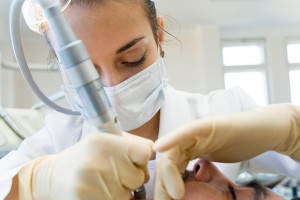The Critical Portion of The Dental Implant To Achieve Immediate Implant Immobility
Authored by: Dr. Young H Kwon DDS, MAGD, DICOI
01/01/2016
I was thinking which portion of the implant is most crucial to establish initial stability and during implant sustainment? My opinion is clinical and empirical point of view is apical end portion of last 3 threads of the implant. The reasons are explained as following:
 1. During implant placement proceedings sometimes, experiencing the looseness of the implant body pathway when encountered with the last 3-4 turn of the implant became solid, they stay firm. This is resulted from the final 3-4 thread of the implant apex end.
1. During implant placement proceedings sometimes, experiencing the looseness of the implant body pathway when encountered with the last 3-4 turn of the implant became solid, they stay firm. This is resulted from the final 3-4 thread of the implant apex end.
2. In actual cases, already placed and served for quite a bit of time some implants were found with severe crestal bone loss horizontally and vertically but as long as the last apical 3-4 threads embedded in bone still stay solid even though significant crestal 2/3 of the bone got lost, that suggests the apical 1/3 of the implant body is a key factor to hold and providing the implant immobility and sustainment in the bone.
3. Scientific fact is according to Seong PHD. PE pressure and stress related to implant body, when side wall of the implant body cannot resist stress, only the implant bottom (apical end) will resist the total pressure.
4. When you look at the bottle and its cover fastening is at the top 3-4 thread of the bottle top. When you close the bottle cover, you don’t exert severe compressive force and vertical force to establish the fastening of the bottle. But the 3-4 threads which fit snuggly and fasten the bottle in position and perform watertight concealment. This is pretty different from screw type implant into bone with remarkable friction and compression dependent implant placement.
5. Also look at the arrowhead which is stuck into the target and stays very tight is the very apical portion of the arrow.
6. In real placement of the dental implant into the bone, apical portion of the implant penetrates the cortical crestal portion and ended at either cortico cancellus or cancellus bone.
In conclusion biomechanically, I can say if the apical end portion of the implant achieves translational equilibrium and rotational equilibrium with surrounding bone at the time of implant placement, the implant just placed can be loaded immediately. In other words, translational equilibrium means three dimensionally implant becomes stationary firm and rotational equilibrium means implant just placed doesn’t turn at all. If the practitioner can satisfy this condition immediately at the time of placement and expect this condition with 100% assurances, then implant practitioner can load the implant immediately without hesitation.
